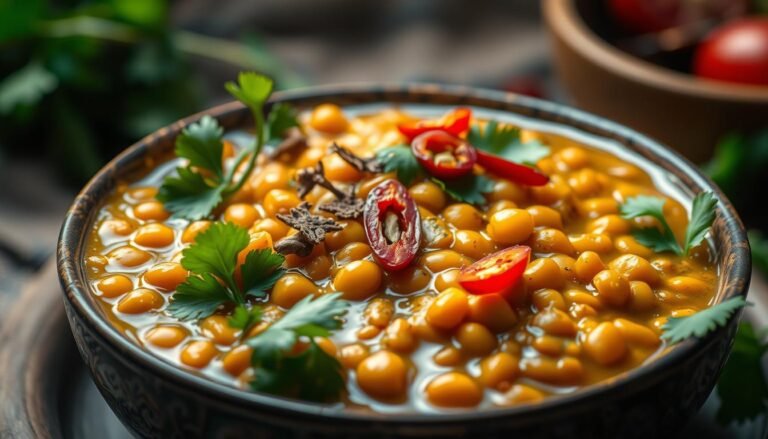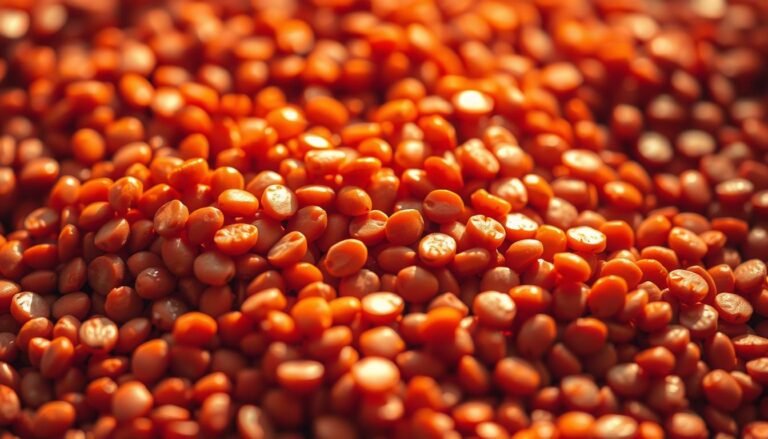Lentils are a type of legume that is rich in nutrients and has been a staple in many cuisines around the world. They are known for their lens-like shape and come in various colors, including brown, green, red, yellow, and black.
Lentils are a nutrient-packed food that provides a range of health benefits. They are an excellent source of protein, fiber, and minerals, making them a great addition to a healthy diet.
In this article, we will explore the nutritional benefits of lentils and discuss their importance in various cuisines. We will also provide tips on how to incorporate lentils into your diet and highlight their versatility in different recipes.
Key Takeaways
- Lentils are a rich source of protein, fiber, and minerals.
- They come in various colors and are versatile in different recipes.
- Lentils have been a staple food in many cultures for centuries.
- They provide a range of health benefits, including reducing the risk of chronic diseases.
- Lentils are easy to incorporate into a healthy diet.
What Are Lentils? Understanding This Ancient Superfood
Belonging to the legume family, lentils are related to beans, soybeans, and peanuts, and have been a vital part of human diets for millennia. They are a nutrient-rich food that has been cultivated for thousands of years, serving as a staple in various cultures around the world.
Botanical Classification and Origin
Lentils are scientifically classified under the genus Lens, with Lens culinaris being the most commonly cultivated species. Originating in the Near East, lentils have been a crucial crop in many ancient civilizations, including those of Egypt, Rome, and Greece. According to recent research on lentils, their adaptability to various climates and soils has contributed to their widespread cultivation.
The botanical characteristics of lentils, such as their small size and varied colors, make them a versatile crop for different culinary and agricultural practices. Their ability to fix nitrogen in the soil also enhances soil fertility, making them a valuable crop in rotation systems.
Historical Significance in Human Diet
Lentils have been a significant component of human diets throughout history, providing a rich source of protein, fiber, and essential nutrients. In ancient times, lentils were not only a food staple but also played a role in cultural and economic exchanges. Their nutritional value and ease of storage made them an ideal food source for many populations.
The historical significance of lentils is evident in their continued consumption across various cultures. From traditional dishes in the Middle East to modern recipes in contemporary cuisine, lentils remain a vital ingredient, reflecting their enduring importance in human nutrition and culinary traditions.
The Nutritional Powerhouse: Lentil Composition Breakdown
Lentils are a nutritional powerhouse, offering a rich blend of essential nutrients that make them an excellent addition to a healthy diet. They have been a staple in many cuisines for centuries, and their nutritional benefits are a key reason for their enduring popularity.
Protein Content and Amino Acid Profile
Lentils are an excellent source of protein, making them a great option for vegetarians and vegans. They contain approximately 18 grams of protein per 100 grams of cooked lentils. The amino acid profile of lentils is also noteworthy, as they are rich in essential amino acids like lysine, leucine, and threonine. However, lentils are low in methionine and cysteine, making it beneficial to consume them with other grains or legumes to achieve a complete amino acid profile.
Fiber, Vitamins, and Minerals
Lentils are rich in dietary fiber, containing both soluble and insoluble fiber. This helps promote digestive health and can aid in managing blood sugar levels. They are also a good source of various vitamins and minerals, including iron, potassium, and folate. Folate is particularly important for pregnant women, as it helps prevent birth defects of the brain and spine. The fiber, vitamins, and minerals in lentils work together to provide numerous health benefits, making them a nutritious addition to meals.
Caloric Value and Macronutrient Balance
Lentils are relatively low in calories, with approximately 230 calories per 100 grams of cooked lentils. They have a good macronutrient balance, being high in complex carbohydrates, moderate in protein, and low in fat. The majority of the fat in lentils is unsaturated, which can help support heart health. Overall, lentils provide a satisfying and nutritious meal option that can be part of a balanced diet.
As research on lentils continues to emerge, it’s clear that these legumes offer a wealth of nutritional benefits. Incorporating lentils into your diet can be a simple and effective way to improve your overall health and wellbeing.
Types of Lentils: A Colorful Spectrum of Varieties
The world of lentils is diverse, with different colors such as brown, green, red, yellow, and black, offering a range of culinary possibilities. This variety not only adds visual appeal to dishes but also caters to different tastes and cooking requirements.
Brown and Green Lentils
Brown and green lentils are among the most commonly consumed types. Brown lentils have a mild flavor and are often used in soups and stews. Green lentils, on the other hand, have a slightly peppery flavor and retain their shape well after cooking, making them ideal for salads.
Red and Yellow Lentils
Red and yellow lentils are known for their bright colors and quicker cooking times compared to their brown and green counterparts. Red lentils break down during cooking, making them perfect for thick, comforting soups and curries. Yellow lentils are often used in Indian cuisine, particularly in dal recipes.
Black and Specialty Lentils
Black lentils, also known as beluga lentils, have a shiny black skin and a rich, earthy flavor. They are great in salads or as a side dish. Specialty lentils, such as Puy lentils from France, are known for their unique flavor profiles and are often used in gourmet cooking.
Australian-Grown Varieties
Australia is a significant producer of lentils, with various regions cultivating different types. Australian-grown lentils are known for their high quality and are often exported. The country’s lentil production is focused on sustainability, ensuring that the environmental impact is minimized.
According to a recent report, “Australian lentils are grown using advanced farming practices that not only improve yield but also reduce environmental footprint.” This makes Australian lentils a preferred choice for both local consumption and international markets.
| Type of Lentil | Characteristics | Culinary Uses |
|---|---|---|
| Brown Lentils | Mild flavor, holds shape | Soups, stews |
| Green Lentils | Slightly peppery, retains shape | Salads, side dishes |
| Red Lentils | Bright color, cooks quickly | Soups, curries |
| Black Lentils | Earthy flavor, shiny black skin | Salads, gourmet dishes |

The diverse range of lentils available allows for a wide array of culinary creativity. Whether you’re cooking a hearty stew or a simple salad, there’s a type of lentil to suit every need.
Health Benefits: Why Lentils Should Be Part of Your Diet
Lentils are a nutritional powerhouse that offers numerous health benefits when consumed regularly. They are rich in essential nutrients, fiber, and protein, making them an excellent addition to a healthy diet.
Heart Health and Cholesterol Management
Lentils are known to support heart health due to their high fiber and potassium content. The soluble fiber in lentils helps to lower cholesterol levels, reducing the risk of heart disease. Research on lentils has shown that their consumption can lead to improved cardiovascular health.
Blood Sugar Regulation and Diabetes Prevention
The fiber and protein in lentils also play a crucial role in regulating blood sugar levels. Lentils have a low glycemic index, which means they are digested slowly, preventing a rapid spike in blood sugar. This makes them an ideal food for managing diabetes and preventing its onset.
Weight Management and Digestive Health
Lentils are not only nutritious but also filling, making them a great aid in weight management. Their high fiber content promotes digestive health by preventing constipation and supporting healthy gut bacteria. Incorporating lentils into your meals can lead to a healthier digestive system and assist in maintaining a healthy weight.
Incorporating lentils into your diet can have a significant impact on your overall health and wellbeing. With their numerous health benefits, lentils are a simple and effective way to improve your diet.
Lentils in the Australian Diet: Local Consumption Patterns
Lentil consumption in Australia has a rich history, with modern trends reflecting a growing appreciation for this nutrient-packed legume. As Australians become more health-conscious, lentils are being recognized for their versatility and nutritional benefits.
A Historical Perspective on Lentils in Australian Cuisine
Lentils have been a part of Australian cuisine for centuries, introduced by early European settlers who brought their culinary traditions with them. Initially, lentils were used in traditional dishes such as soups and stews. Over time, Australian cuisine has evolved, incorporating lentils into a variety of modern recipes.
The historical significance of lentils in Australian cooking is also influenced by the country’s multicultural heritage. Immigrants from the Middle East, India, and the Mediterranean have introduced their own lentil-based dishes, enriching the local culinary landscape.
Modern Consumption Trends in Australia
In recent years, there has been a noticeable increase in lentil consumption across Australia. This trend is driven by growing awareness of the health benefits associated with lentils, including their high protein content, fiber, and nutrient density.
Modern Australian cooking often features lentils in innovative dishes, from salads and curries to veggie burgers and pasta sauces. The rise of plant-based diets has further boosted lentil popularity, as they offer a versatile and nutritious alternative to meat.
Cooking with Lentils: Basic Preparation Methods
Lentils are a versatile ingredient, and mastering their preparation is key to unlocking their nutritional benefits. Research on lentils has shown that proper cooking techniques can enhance their digestibility and nutritional availability.

Soaking: Necessary or Optional?
Soaking lentils can reduce cooking time and improve digestibility. However, it’s not always necessary, as some types of lentils cook quickly without soaking. For lentil nutrition info, it’s worth noting that soaking can help retain some of the delicate nutrients found in lentils.
Boiling and Simmering Techniques
Boiling and simmering are traditional methods for cooking lentils. To boil lentils, simply add them to a pot of salted water, bring to a boil, then reduce the heat to a simmer. Cooking times vary depending on the type of lentil, but most cook within 20-40 minutes. Simmering helps to preserve the nutrients and texture of the lentils.
Pressure Cooking and Modern Methods
Pressure cooking is a convenient and time-efficient way to cook lentils. It can reduce cooking time by up to 50% and help retain nutrients. Modern pressure cookers and instant pots have made it easier to cook lentils to perfection. For those looking for quick and nutritious meal solutions, pressure cooking lentils is a valuable technique to master.
In conclusion, cooking lentils is a simple process that can be adapted to various cooking methods and preferences. By understanding the basics of lentil preparation, home cooks can unlock the full nutritional potential of this versatile legume.
Lentil Articles: Recent Research and Nutritional Findings
Lentils have been gaining attention in the scientific community due to their rich nutritional content and potential to reduce chronic diseases. As a result, numerous studies have been conducted to further understand the benefits of incorporating lentils into one’s diet.
Latest Scientific Studies on Lentil Benefits
Recent studies have highlighted the nutritional benefits of lentils, including their high protein and fiber content, as well as their rich array of vitamins and minerals. Lentils have been shown to help reduce cholesterol levels and improve heart health. Additionally, they have been found to have a positive impact on blood sugar regulation, making them a valuable component of a diet for individuals with diabetes.
The scientific community continues to explore the potential health benefits of lentils, with ongoing research examining their role in weight management and digestive health. As research on lentils continues to evolve, it is becoming increasingly clear that they are a valuable addition to a healthy diet.
Australian Research Contributions
Australian researchers have made significant contributions to the study of lentils, with a focus on their nutritional benefits and potential health outcomes. Studies conducted in Australia have investigated the impact of lentil consumption on cardiovascular health, with promising results. Australian research has also explored the role of lentils in sustainable agriculture, highlighting their potential as a crop that can improve soil health and reduce environmental impact.
The findings from Australian research on lentils have important implications for public health and nutrition policy, both locally and globally. As lentil news continues to emerge, it is likely that lentils will play an increasingly prominent role in discussions around healthy eating and sustainable food systems.
Lentils in Global Cuisines: International Inspirations
The versatility of lentils is celebrated across the world, featuring in a myriad of traditional and contemporary dishes. Lentils have become an integral part of various cuisines, thanks to their nutritional value and adaptability in different recipes.
Middle Eastern Lentil Dishes
In Middle Eastern cuisine, lentils are a staple ingredient, often used in hearty stews and soups. One popular dish is shurpa, a comforting lentil soup flavored with aromatic spices. Lentils are also used in salads, such as the salatet khodra, a refreshing mix of lentils, vegetables, and herbs.
Indian Subcontinent Lentil Specialties
The Indian subcontinent is renowned for its diverse lentil-based dishes. Dal makhani, a popular Punjabi dish, is made with black lentils and kidney beans in a creamy tomato-based sauce. Another staple is sambar, a lentil-based vegetable stew that is a mainstay in South Indian cuisine.
Mediterranean Lentil Recipes
Mediterranean cuisine also makes extensive use of lentils, often incorporating them into salads and stews. A classic example is the Greek fava, a dish made from yellow split peas, but often lentils are used as a substitute or addition. Lentil salads, flavored with olive oil, garlic, and herbs, are a common feature in Mediterranean diets.
Australian Fusion Lentil Dishes
In Australia, lentils are being incorporated into modern fusion dishes, blending traditional culinary techniques with contemporary flavors. Chefs are experimenting with lentil-based curries, salads, and stews, often combining lentils with locally sourced ingredients to create innovative recipes.
Lentils continue to be a vital ingredient in global cuisines, offering a wealth of nutritional benefits and culinary possibilities. As people become more adventurous in their eating habits, the popularity of lentil-based dishes is likely to grow, further enriching the culinary landscape.
Storing and Preserving Lentils: Maximizing Shelf Life
The longevity of lentils depends on how they are stored and preserved. Lentils are a versatile and nutritious food, and maintaining their quality is crucial for both culinary and nutritional purposes.
Dry Storage Best Practices
To keep lentils fresh, store them in a cool, dry place. Use airtight containers to protect against moisture and pests. According to recent research on lentils, maintaining a consistent temperature below 70°F (21°C) can significantly extend shelf life. It’s also beneficial to keep them away from direct sunlight and heat sources.
Freezing and Preserving Cooked Lentils
Cooked lentils can be frozen for later use, making meal prep convenient. Cool the lentils completely before transferring them to airtight containers or freezer bags. Label the containers with the date and contents. Frozen lentils can be stored for up to 6 months. When you’re ready to use them, simply thaw and reheat. This method is a great way to reduce food waste and save time during busy weeknights.
By following these storage and preservation tips, you can enjoy lentils at their best, whether you’re cooking from scratch or using leftovers. Staying updated with the latest lentil news can also provide insights into new storage methods and recipes.
Lentil Farming in Australia: From Field to Table
Australia’s lentil farming industry is thriving, with various regions across the country suitable for lentil cultivation. The country’s diverse climate and soil conditions allow for a range of lentil varieties to be grown, contributing to a robust agricultural sector.
Growing Regions and Conditions
Lentils are grown in several key regions across Australia, including South Australia, Victoria, and parts of Western Australia. These regions offer the ideal combination of soil type, rainfall, and temperature required for lentil production. For instance, South Australia is known for its high-quality lentil crops due to its favorable climate and rich soil.
Economic Impact of Australian Lentil Production
The economic impact of lentil production in Australia is significant. Lentil farming contributes substantially to the agricultural GDP and provides employment opportunities in rural areas. The industry also plays a crucial role in the country’s export market, with Australian lentils being sought after globally for their quality and nutritional value.
| Region | Lentil Production (Tons) | Economic Contribution ($AUD) |
|---|---|---|
| South Australia | 100,000 | 50 million |
| Victoria | 80,000 | 40 million |
| Western Australia | 70,000 | 35 million |
The lentil industry’s growth is supported by ongoing research into improved farming practices and lentil varieties, enhancing both yield and nutritional content. As consumers increasingly seek out lentil-based products for their nutritional benefits, as highlighted in various lentil articles and studies on lentil nutrition info, the demand for Australian lentils is expected to continue growing.
Sustainability Champion: The Environmental Impact of Lentils
Lentils have emerged as a sustainability champion in the agricultural world, thanks to their remarkable environmental benefits. As the global population continues to grow, the need for sustainable food sources becomes increasingly important. Lentils, with their low environmental footprint, are well-positioned to meet this demand.
Water and Land Use Efficiency
Lentils are known for their drought tolerance and low water requirements, making them an ideal crop for water-scarce regions. They also have a low land use requirement compared to other protein sources, as they can be grown in rotation with other crops, improving soil health and reducing the need for additional land.
Efficient water use and land management practices associated with lentil cultivation contribute to their sustainability profile. Research on lentils has shown that they can thrive in challenging environmental conditions, further enhancing their appeal as a sustainable crop.
Carbon Footprint Compared to Animal Proteins
When compared to animal proteins, lentils have a significantly lower carbon footprint. The production of lentils generates fewer greenhouse gas emissions, making them a more environmentally friendly option for consumers looking to reduce their dietary carbon impact.
Studies have consistently shown that plant-based proteins like lentils offer a more sustainable alternative to animal-based proteins. As consumers become more aware of the environmental impact of their food choices, lentil news and research continue to highlight the benefits of incorporating lentils into one’s diet.
Common Myths and Misconceptions About Lentils
Despite their popularity, lentils are often misunderstood, with many myths clouding their true nutritional benefits and cooking techniques. Lentils have been a dietary staple for thousands of years, providing a rich source of protein, fiber, and essential nutrients. However, misconceptions about their nutritional value and preparation methods persist.
Addressing Nutritional Myths
One common myth is that lentils are not a complete protein source. However, when combined with whole grains, they form a complete protein, making them an excellent option for vegetarians and vegans. Another misconception is that lentils are high in calories, when in fact, they are relatively low, with a cup of cooked lentils containing about 230 calories.
Nutritional Comparison:
| Food Item | Protein Content | Calorie Count | Fiber Content |
|---|---|---|---|
| Lentils (1 cup cooked) | 18g | 230 | 16g |
| Chicken Breast (1 cup cooked) | 31g | 260 | 0g |
| Quinoa (1 cup cooked) | 8g | 222 | 5g |
Cooking Misconceptions Clarified
Many believe that lentils require lengthy soaking times, but this is not always necessary. While soaking can reduce cooking time, it’s not required for all types of lentils. Green and brown lentils typically need less preparation than larger, firmer varieties.
Lentils for Special Diets: Versatility Across Dietary Needs
For individuals with specific dietary needs, lentils offer a versatile and nutritious solution. Lentils are a nutrient-rich food that can be easily incorporated into various special diets, providing essential proteins, fibers, and minerals.
Lentils in Vegetarian and Vegan Diets
Lentils are an excellent source of protein for vegetarians and vegans. They can be used as a substitute for meat in many dishes, providing a similar texture and a boost of nutrients. According to recent research on lentils, they are rich in essential amino acids, making them a valuable component of plant-based diets.
Gluten-Free and Allergen Considerations
Lentils are naturally gluten-free, making them an excellent option for individuals with gluten intolerance or celiac disease. They are also low on the list of common allergens, providing a safe and nutritious choice for those with dietary restrictions. Lentils can be used to create a variety of gluten-free products, from soups to baked goods.
Lentils in Sports Nutrition
Athletes and fitness enthusiasts can benefit from lentils as a source of complex carbohydrates, protein, and fiber. Lentils provide sustained energy and support muscle recovery, making them an excellent addition to sports nutrition plans. Recent lentil news highlights their potential in enhancing endurance and performance.
In conclusion, lentils are a versatile ingredient that can cater to various special dietary needs. Their nutritional profile and adaptability make them an ideal choice for vegetarians, vegans, gluten-free diets, and sports nutrition.
Innovative Uses: Beyond Traditional Lentil Dishes
Lentils are experiencing a renaissance of sorts, with chefs and food manufacturers exploring novel uses for this nutrient-rich legume. Beyond their traditional role in soups and stews, lentils are being reimagined in various innovative applications.
Lentil Flour and Baking Applications
One of the most exciting developments is the use of lentil flour in baking. Lentil flour adds protein, fiber, and a subtle nutty flavor to baked goods. It’s being used to create innovative products like lentil-based bread, muffins, and even gluten-free options.
Lentil Sprouts and Microgreens
Lentil sprouts and microgreens are gaining popularity for their nutritional benefits and culinary versatility. These young, nutrient-dense versions of lentils are being used in salads, as garnishes, and in high-end restaurant dishes.
Lentil-Based Meat Alternatives
The rise of plant-based diets has led to the development of lentil-based meat alternatives. Lentils are being used to create protein-rich, sustainable alternatives to traditional meat products, offering consumers more environmentally friendly options.
These innovative uses of lentils not only expand their culinary potential but also contribute to a more sustainable food system. As consumers become more health-conscious and environmentally aware, the demand for lentil-based products is likely to grow.
Conclusion: Embracing Lentils in Your Daily Diet
Lentils are a nutritious and versatile ingredient that can be easily incorporated into daily meals, providing a rich source of protein, fiber, and essential nutrients. Recent research on lentils highlights their potential in supporting heart health, managing blood sugar levels, and aiding in weight management.
Staying updated with the latest lentil news and lentil articles can help you discover new ways to include these legumes in your diet. From traditional recipes to modern lentil-based products, the options are vast and varied. Understanding lentil nutrition info is key to unlocking their full health benefits.
By incorporating lentils into your meals, you can not only enhance the nutritional value of your diet but also explore a world of flavors and cuisines. Whether you’re looking to adopt a more sustainable eating habit or simply seeking to diversify your meals, lentils offer a delicious and healthy solution.





